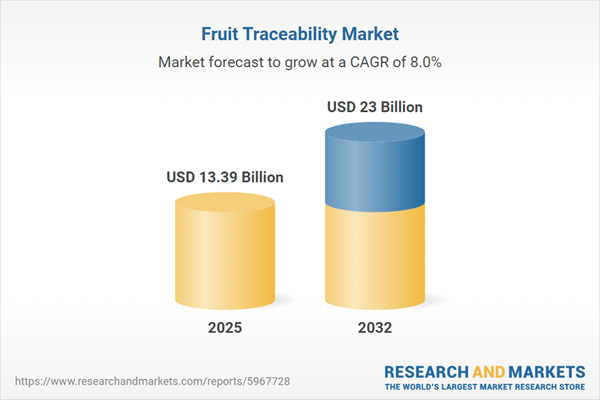Speak directly to the analyst to clarify any post sales queries you may have.
Senior leaders face fast-changing compliance requirements and complex global operations as the fruit traceability market advances through digital transformation. Traceability solutions are now central to risk management and operational efficiency, enabling organizations to meet transparency, regulatory, and adaptation challenges across evolving supply chains.
Market Snapshot: Fruit Traceability Market Size and Growth
The fruit traceability market reached USD 12.42 billion in 2024 and is expected to increase to USD 13.39 billion by 2025, with a projected value of USD 23 billion by 2032. This growth, representing an estimated 8% CAGR, is propelled by accelerated adoption of digital authentication and tracking platforms, as well as more rigorous compliance expectations worldwide. Influencing factors include a surge in regional oversight programs, growing demand for transparency from consumers, and deeper complexities in cross-border logistics. The market is further shaped by modular technology solutions and strategies that boost adaptability for both regulatory and operational transformation.
Scope & Segmentation
This report delivers a comprehensive overview to support digital transformation initiatives and streamline compliance management in the fruit supply chain. The segmentation framework offers senior decision-makers actionable intelligence to align leadership priorities and manage risk effectively.
- Technology: Blockchain creates secure audit trails; GPS geofencing validates shipment movement; IoT sensors monitor real-time environmental factors; QR code and RFID tools authenticate product lines.
- Component: Cloud platforms support scalability; middleware provides analytics; mobile applications enable data collection at source; enterprise software connects processes; custom tags facilitate regulatory identification.
- Application: Traceability solutions support anti-fraud initiatives, maintain cold-chain standards, streamline compliance records, improve logistics forecasting, and uphold product quality in transit.
- Deployment Mode: Organizations leverage cloud, hybrid, and on-premises deployments to address both local and global collaboration needs and comply with regional regulations.
- End User: Producers, logistics firms, retailers, and food service operators utilize traceability to strengthen compliance, accelerate workflow, and ensure consistent quality across geographies.
- Solution: Integrated hardware, real-time analytics, targeted regulatory consultancy, and personalized support cover the complexity of varied supply chain models.
- Geography: The Americas emphasize inter-company cooperation, EMEA seeks regulatory harmonization, and Asia-Pacific focuses on fast-tracked digital adoption in response to shifting compliance and market conditions.
Fruit Traceability Market: Key Takeaways
- Modern traceability platforms facilitate transparent, secure information sharing, boosting collaboration among producers, logistics providers, and retailers worldwide.
- Integrating IoT and blockchain enables risk mitigation and faster responses to changing regulations, supporting stronger market compliance.
- Interoperability across diverse technology systems reduces integration challenges and encourages unified data access for supply chain oversight.
- Effective anti-counterfeiting and logistics solutions support compliance, reduce fraud, and increase efficiency for cross-border fruit movements.
- Regional approaches differ: the Americas concentrate on collaboration, EMEA addresses policy consistency, and Asia-Pacific prioritizes digital innovation for accelerating operational improvements.
- Robust traceability frameworks enhance brand reputation and allow supply chain strategies to adjust to evolving market factors and regulations.
Tariff Impact: Navigating US Trade-Driven Market Realignment
Evolving US tariff frameworks are prompting supply chain leaders to adapt procurement and distribution models. Many organizations are shifting toward regional sourcing and nearshoring to reduce exposure to trade uncertainties. Comprehensive traceability platforms are now essential for maintaining regulatory compliance, supporting business continuity, and managing trade policy risk in this evolving environment. Investing in digital infrastructure drives supply chain resilience and reliable operational performance during periods of regulatory transition.
Methodology & Data Sources
Report insights are derived from direct interviews with technology vendors, supply chain executives, and regulatory authorities. A multi-stage triangulation method was used to verify data and ensure impartial, accurate findings.
Why This Report Matters
- Equips executive teams with strategies for targeted digital investment to enhance risk management and world-class compliance in international fruit supply chains.
- Highlights emerging market opportunities and details how advanced technologies improve business agility, reducing operational complexity and maximizing digital returns.
- Provides actionable frameworks to improve traceability, manage operational risk, and optimize oversight from farm to consumer.
Conclusion
With this analysis, supply chain leaders are empowered to manage complex regulatory demands and digital adoption, facilitating greater transparency and strategic readiness for future challenges.
Additional Product Information:
- Purchase of this report includes 1 year online access with quarterly updates.
- This report can be updated on request. Please contact our Customer Experience team using the Ask a Question widget on our website.
Table of Contents
3. Executive Summary
4. Market Overview
7. Cumulative Impact of Artificial Intelligence 2025
Companies Mentioned
The companies profiled in this Fruit Traceability market report include:- IBM Corporation
- SAP SE
- Oracle Corporation
- Honeywell International Inc.
- TE-FOOD GmbH
- FoodLogiQ, Inc.
- Zest Labs, Inc.
- OriginTrail Ltd.
- Clarifruit Ltd.
- Ripe.io Inc.
Table Information
| Report Attribute | Details |
|---|---|
| No. of Pages | 180 |
| Published | October 2025 |
| Forecast Period | 2025 - 2032 |
| Estimated Market Value ( USD | $ 13.39 Billion |
| Forecasted Market Value ( USD | $ 23 Billion |
| Compound Annual Growth Rate | 8.0% |
| Regions Covered | Global |
| No. of Companies Mentioned | 11 |









